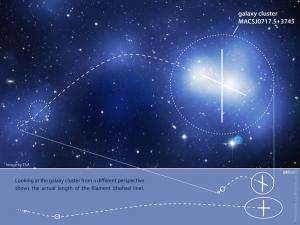Astronomers develop technique for mapping the universe in 3-D

Combining observations from Mauna Kea with data taken by telescopes in space, astronomers at the Institute for Astronomy (UH Manoa) and their collaborators have developed a technique that allows them to map collisions of giant galaxy clusters in three dimensions.
Astronomers studying the solar system are fortunate. Their targets move, rotate, obscure and deflect each other on timescales of hours, months or years, allowing researchers to see them from different angles. Scientists exploring the distant universe are at a disadvantage in this regard. Most of their targets, such as black holes, galaxies, or clusters of galaxies, are so huge that it takes tens or hundreds of millions of years for an object to present us with a noticeably changed view.
"Being unable to see these large-scale structures from different angles makes it very difficult to figure out their three-dimensional shapes, let alone their relative motions and interactions," explains Harald Ebeling, IfA astronomer and an expert on galaxy clusters. "All we see in our images is a 2-D projection of a 3-D structure onto the plane of the sky."
Luckily, when two galaxy clusters collide, astronomers can make use of a clever combination of observations to make the invisible visible. In three recent studies, Dr. Ebeling and an international team of collaborators created 3-D models of merging galaxy clusters. Creating these models requires mapping all the components of a cluster: the galaxies that we see in visible light, the hot gas permeating the cluster that emits X-rays, and the invisible dark matter that can be detected only because its gravity distorts the images of objects behind the cluster.
To collect all these data, Ebeling's team used three world-class observatories: the Mauna Kea Observatories (specifically, the Keck I telescope of the W.M. Keck Observatory and the Canada-France-Hawaii Telescope), the Chandra X-ray Observatory and the Hubble Space Telescope.
Combining the data to create a credible 3-D model of a complicated system like a merging cluster still involves much physical interpretation. Admits Li-Yen Hsu, IfA graduate student and lead author of one of the three studies, "Our understanding of the shape and motion of the cluster kept evolving as we added more and more observational evidence. It's a little like solving a jigsaw puzzle with half of the pieces missing."
Eventually, enough pieces of the puzzle were collected to unravel, for instance, the geometry of MACSJ0717.5+3745, a giant triple merger of clusters fed by a filament of dark matter that extends 60 million light-years into space. The team was also able to measure the mass of the entire structure and found that filaments may contain more than half of the mass of the entire universe.
Two other cluster mergers, examined in studies led by Hsu and fellow IfA graduate student I-Ting Ho, turned out to proceed along trajectories that are much more complex than suggested by the systems' appearance in projection on the sky. By revealing these objects' 3-D geometry, scientists can now correct for projection effects and determine the true properties of merging clusters.
The results of these 3-D reconstructions of some of the most massive structures in the universe will appear in three articles to be published by the Monthly Notices of the Royal Astronomical Society.
More information: www.ifa.hawaii.edu/info/press- … leases/3-D_Universe/
Provided by University of Hawaii at Manoa

















